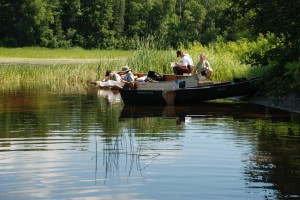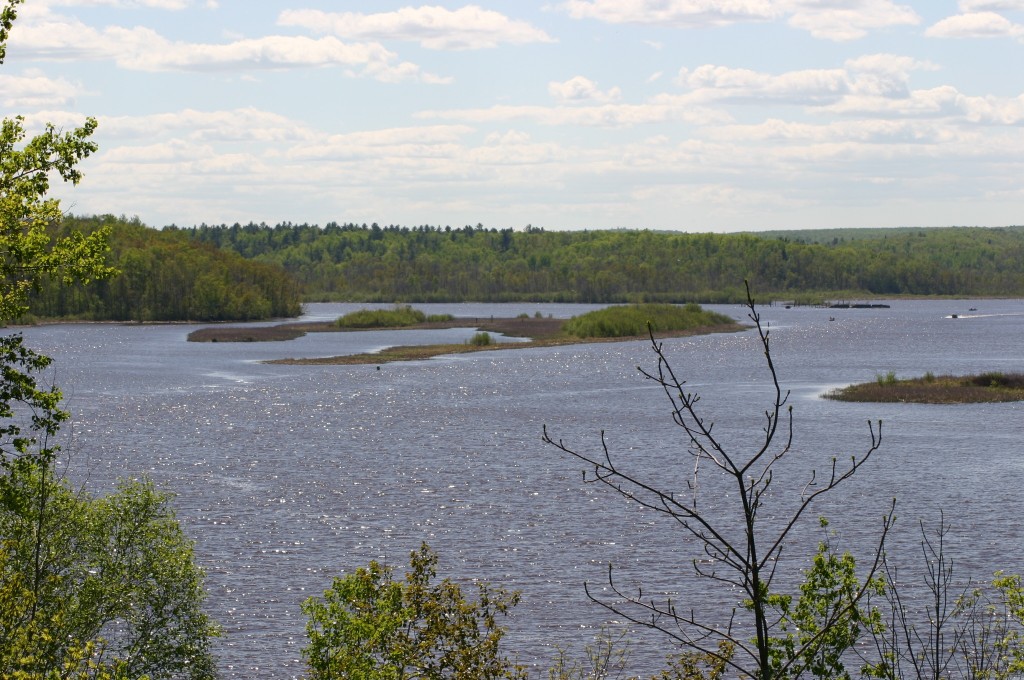
Monitoring in the Pokegama Bay of the St. Louis River. Photo: Amy Elliot
By Brian Bienkowski
The fight against climate change, invasive species and contaminated water in the Great Lakes was taken to the Lake Superior shoreline in Wisconsin last week. The National Oceanic and Atmospheric Administration designated 17,000 acres there for research, education, outreach and stewardship.
The four parcels of land are the newest additions to a federal and state partnership to protect the areas where rivers meet large bodies of water. Managed by the University of Wisconsin-Extension, the Lake Superior National Estuarine Research Reserve is comprised of public land where the St. Louis River meets Lake Superior.
Research conducted there will allow for a better understanding of freshwater estuaries and coastal resources and will guide land management for the reserve and similar ecosystems, said Becky Sapper, outreach coordinator for the Lake Superior reserve.
The reserve will provide educational opportunities, increase awareness among policymakers and protect the ecological health of the sites, said Sapper. Staff will work with teachers to develop classes about Great Lakes estuaries, invasive species and climate change impacts. A library of research findings will be a reference for local government officials.
NOAA provides 70 percent of the funding; Wisconsin provides the rest. Established in 1972, the

The St. Louis River. Photo: Becky Sapper.
National Estuarine Research Reserve System is comprised of 28 freshwater and ocean estuarine reserves. Research teams learn from each other, said Matt Chasse, a program specialist with the system. Findings from the reserves are made available to NOAA.
The reserve will be overseen by a board representing municipal, university, tribal, citizen and state government interests.
A management plan drafted during the site selection phase identifies areas of concern — food webs, invasive species, climate change and contaminants.
“Certain areas have been identified, but this is a vast ecosystem, and those areas of interest may change,” Sapper said.
The plan identifies seven objectives:
- Conduct research and monitoring
- Improve understanding of the estuary’s social and economic impacts
- Increase public awareness
- Increase educator and student understanding
- Outreach to coastal decision makers
- Conduct stewardship activities
- Encourage citizen volunteering
The research, education, coastal training and system-wide monitoring program will each have a coordinator to help achieve these objectives.
The designation comes after six years of site selection, environmental impact study and drafting of a management plan. The reserve is the lone representative in the system from the upper Great Lakes, and only the second reserve in the Great Lakes region. The Old Woman Creek Research Reserve on the southwestern shore of Lake Eerie was designated in 1980.
Its location on the Great Lakes coupled with its diverse mix of woodlands, shrublands, grasslands, marshes and swamps, led the NOAA to accept the nomination in 2008. It then began working with the University of Wisconsin-Extension and state agencies to develop a management plan and conduct an Environmental Impact Statement, said Chasse.
“We are definitely short on freshwater estuaries,” said Chasse. “This site allow us to fill that void.”
The strong network of organizations studying the St. Louis River estuary was crucial to site selection, said Sapper. The University of Wisconsin-Superior, The University of Minnesota-Duluth and the Freshwater Folk organization are engaged in research in the area, giving the Lake Superior reserve staff a pool of resources.
“There was an outpouring of support for these sites,” said Sapper. “This area is beautiful and we are really excited to get started.”
Pingback: Great Lakes scientists educate communities; put research to work … | The Information Reserve Site